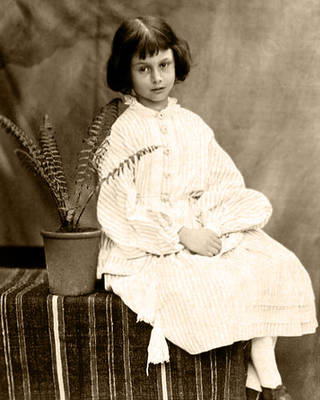Not everything in 'Alice's Adventures in Wonderland' was conjured from Lewis Carroll's imagination. Stubborn, precocious and curious, the character of Alice was based on a real little girl named Alice Liddell, with a brunette bob and short fringe.
Alice Liddell was no ordinary muse: she nagged, bossed and bullied Dodgson into writing down her story. She stares out from photographs in a peculiarly modern manner, both attracting and repelling our gaze. Alice Liddell in Wonderland, still as relevant as ever.

Alice Liddell was almost five years old when she first met the mathematician Charles Lutwidge Dodgson, better known by his pen name Lewis Carroll. She lived at Christ Church College at the University of Oxford, where her father was the Dean and Dodgson was a maths tutor. With Dodgson's study adjoining the Liddells' lodgings, he soon became friend, photographer and storyteller to the Liddell family.
The Alice stories were first created one legendary 'golden afternoon' on 4 July 1862. While entertaining the three Liddell sisters, Alice, Lorina and Edith, during a boating trip, Dodgson improvised the story that would become Alice's Adventures in Wonderland. The main character, Alice, shared many characteristics with Alice Liddell, being stubborn, precocious and curious, (although the famous illustration of Alice by John Tenniel would depart strongly from Liddell's brunette bob and short fringe).

Liddell urged Dodgson to write the story down, and he gifted her the first manuscript, which he illustrated himself, in November 1864, titled Alice's Adventures Under Ground. The story was eventually published with illustrations by John Tenniel as Alice's Adventures in Wonderland in 1865, followed by Alice Through the Looking Glass in 1871 – the beginning of a global phenomenon.
Whilst Dodgson (Carroll) went on to achieve fame as the story's author, the 'real' Alice evaded public attention. At Christ Church she was tutored by the leading 19th-century English art critic, John Ruskin, who supported and encouraged her talent for drawing. In December 1871, aged 19, she embarked upon a Grand Tour of Europe with her sisters Edith and Lorina, writing diligently in a travel journal and sketching the sights along the way. While in Naples, she wrote of the "showers of stones and lumps of red hot stuff and puffs of smoke" as the three sisters boldly conquered the summit of Mount Vesuvius. It erupted soon after.

It was during a family holiday in Freshwater, on the Isle of Wight, that Alice first encountered the photographer Julia Margaret Cameron, who was part of a local bohemian circle, including the poet Alfred Tennyson, actress Ellen Terry and artist George Frederic Watts. Cameron photographed Alice Liddell and her sisters several times in the 1870s, producing some of her most remarkable work. She portrayed Alice as numerous classical figures, including the goddesses Pomona, Alethea and Ceres. As Pomona, still with her signature fringe and hand on hip, Alice Liddell appears strikingly modern.

Cameron also photographed Alice and her sisters together in a pose reminiscent of The Three Graces, an ancient mythological motif depicting the daughters of Zeus. The photograph recalls early images of the three sisters in a triptych taken by Charles Dodgson – the 'golden afternoon' revisited.

On 15 September 1880 Alice married Reginald Hargreaves – a pupil of Dodgson's at Christ Church – at Westminster Abbey. Together they raised three sons: Alan (b.1881), Leopold (b.1883) and Caryl (b.1887). Settled in the family home of Cufnells, Hampshire, she continued to evade the public eye until 1928, when financial hardship forced her to sell the original manuscript given to her by Dodgson to an American collector. Alice was by then widowed, with two sons lost in the First World War and death duties to pay, but the loss to the UK of the iconic manuscript provoked national outcry.

This sale, coupled with her visit to the United States in 1932 for the Lewis Carroll centenary celebrations at Columbia University, saw Alice's fame skyrocket. She received an Honorary Degree from Columbia for her services to literature, delivered an address that was broadcast across the world and was consulted on a new Paramount film adaptation of the story, released in 1933. Alice Hargreaves died on 16 November 1934, sparking tributes to the departed 'Alice in Wonderland'. In 1948, the original manuscript was returned to the UK, as a thank you for fighting alongside the US in the Second World War. Alice Liddell had never expected to inspire a cultural phenomenon, but it led her on an extraordinary adventure. Her legacy continues to enrich our understanding and enjoyment of the iconic and enduring Alice's Adventures in Wonderland.


